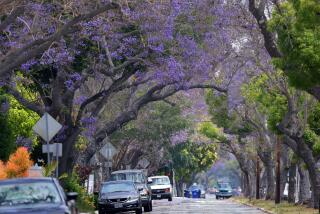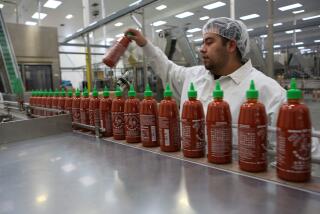Drought devastates cherry crop, puts some growers out of business

A winter heat wave, late frosts and mandatory water restrictions devastated this year’s Leona Valley cherry crop.
LEONA VALLEY, Calif. — Dave Shields started the engine of his tractor on a recent weekday and began toppling the hundreds of drought-stricken cherry trees he and his wife planted 15 years ago in this north Los Angeles County foothills community.
A winter heat wave, late frosts and marauding ravens and bark beetles devastated much of this year’s cherry crop; then came monthly irrigation bills of up to $900. Shields’ 2 1/2-acre C & D Cherries had become a financial burden the family could no longer afford.
The orchard, about 10 miles west of Palmdale, is among 20 cherry ranch operations that, like C & D Cherries, usually open their gates for a few weekends in early June to hordes of “U-pick ‘Em” customers.
“We hear talk about a lot of rain heading our way this winter,” said Shields, president of the Leona Valley Cherry Growers Assn. “But we can’t afford to wait for rain. We’re going out of business and selling the property.”
The 71-year-old retired Los Angeles City Fire Department heavy equipment operator said he can get a higher price if the land has no trees.
Longtime growers say this year’s cherry crop was the worst ever in the valley’s 35 square miles of rambling, country-style homes, orchards and pasturelands best known for its annual Leona Valley Cherry Parade and Festival in early June.
The event pays tribute to the “pick your own” cherries that have become the focus of popular family outings for visitors from Los Angeles, Kern, Orange and Ventura counties.
This year, however, not one ripe cherry dangled from a tree in the valley when the parade kicked off June 6. Pies for the pie-eating contest were baked with cherries from supermarkets in Palmdale, said David Clayton, a spokesman for the Leona Valley Improvement Assn.
“I’ve never seen it this bad,” said Clayton, who moved here in 1979. “Only five of our orchards even opened this year.”
David Bracken, a deputy commissioner for the Los Angeles County Department of Agriculture, was not surprised.
“Cherries are a very finicky, vulnerable and delicate crop that has marginally prospered in certain pockets of Southern California,” he said. But with higher temperatures and increasing competition for available water resources, the future of cherries in these areas is waning, he said.
Cold weather, occasional frost and snow — at the right time of year — were key to Leona Valley’s reputation as a cherry paradise, according to Don Hobart, 84, who helped launch the public picking festivities here with 265 fruit trees he planted in 1959.
By the 1980s, more than 8,000 cherry trees thrived in about 30 cherry orchards, providing ranchers with generous tax deductions for fertilizer, ranch machinery, computers, software, telephones and advertising. The growers established a hotline to tell people when the orchards are open and how to reach them.
Today, six growers remain in the association, and the hotline’s recorded message is disappointing: “As of June 3, 2015, unfortunately due to the low crop this year, all orchards in the association are sold out.”
“Mother Nature is being pretty tough on us,” Hobart said. “I feel bad about that.”
Most Leona Valley growers are retired, like Shields, or have another job to pay the bills, and run cherry orchards as small side businesses.
A mile away from C & D, Loren Worthington, 36, presides over an orchard called The Cherry House, where clear sap oozing from tree limbs signaled an infestation of wood-boring beetles. “When drought sets in and water gets low, you get bark beetles,” he said.
At nearby Windy Ridge Cherries, one of the few robust crops in the valley this year was devoured by ravens and starlings before it could be sold, growers said.
C & D, which declared a crop loss of 50%, found it increasingly difficult to sustain its thirsty trees without violating the for-profit California Water Service Co.’s order that customers cut back by 36% from their usage in 2013 or face steep penalties.
In the hot summer months, its 200 cherry trees require 1,800 gallons a day, an expense this year’s harvest could not cover.
On June 1, Shields and his wife, Cindy, made their way across the orchard and said goodbye to the trees they had nurtured with fertilizer, pruning, weeding and irrigation. “Then I turned off their water,” Shields said.
“Raising cherries was a dream we chased here for a while,” he said, throttling up the tractor to knock down another cherry tree. “Now, we’re moving on.”
More to Read
Sign up for Essential California
The most important California stories and recommendations in your inbox every morning.
You may occasionally receive promotional content from the Los Angeles Times.











